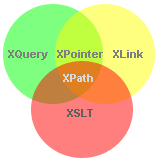XPath Tutorial
What is XPath?
XPath is a major element in the XSLT standard.
XPath can be used to navigate through elements and attributes in an XML document.

|
|
XPath Path Expressions
XPath uses path expressions to select nodes or node-sets in an XML document.
These path expressions look very much like the path expressions you use with traditional computer file systems:

XPath Standard Functions
XPath includes over 200 built-in functions.
There are functions for string values, numeric values, booleans, date and time comparison, node manipulation, sequence manipulation, and much more.
Today XPath expressions can also be used in JavaScript, Java, XML Schema, PHP, Python, C and C++, and lots of other languages.
XPath is Used in XSLT
XPath is a major element in the XSLT standard.
With XPath knowledge you will be able to take great advantage of your XSLT knowledge.
XPath is a W3C Recommendation
XPath 1.0 became a W3C Recommendation on November 16, 1999.
XPath 2.0 became a W3C Recommendation on January 23, 2007.
XPath 3.0 became a W3C Recommendation on April 8, 2014.

